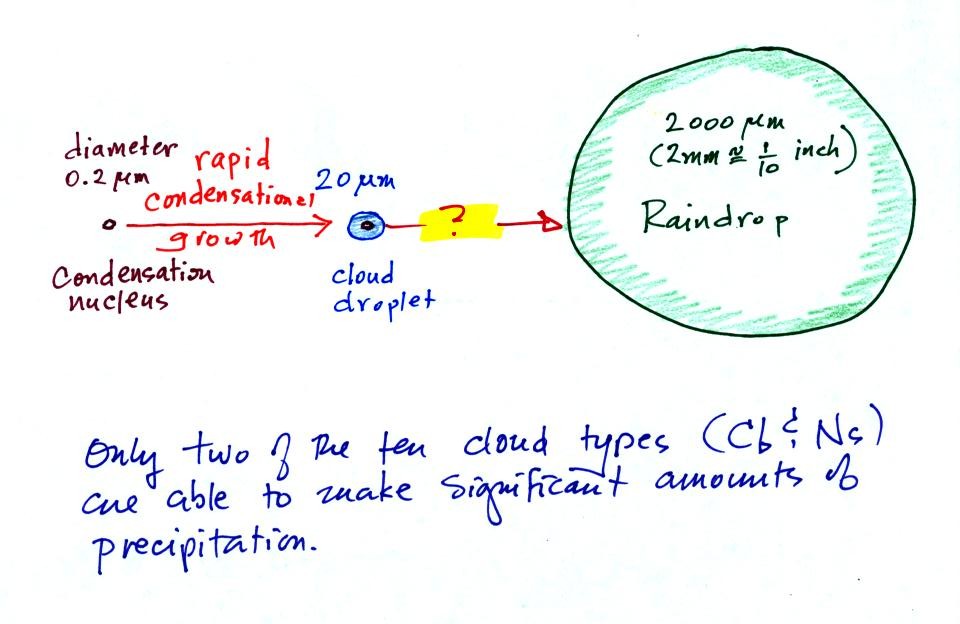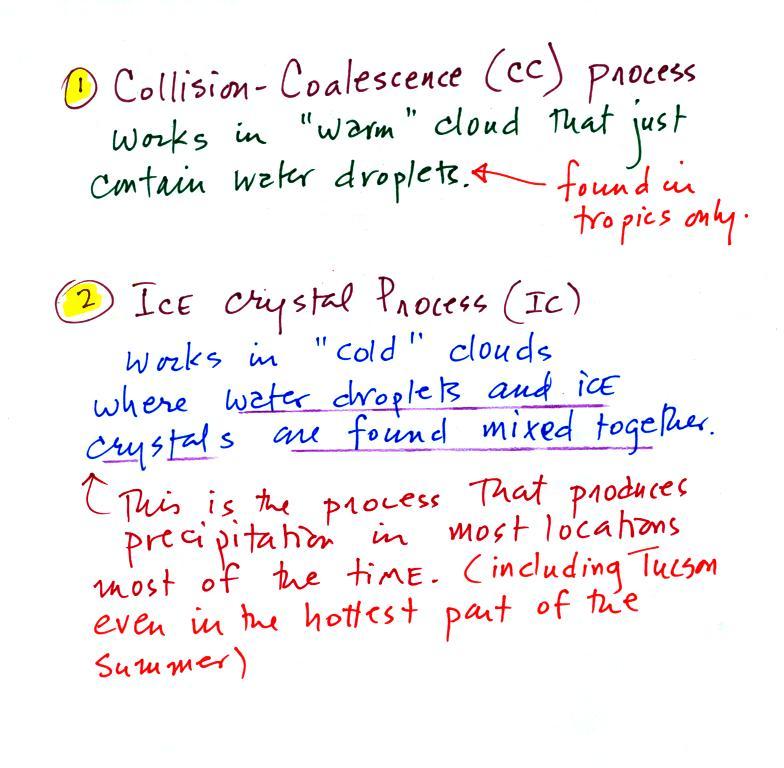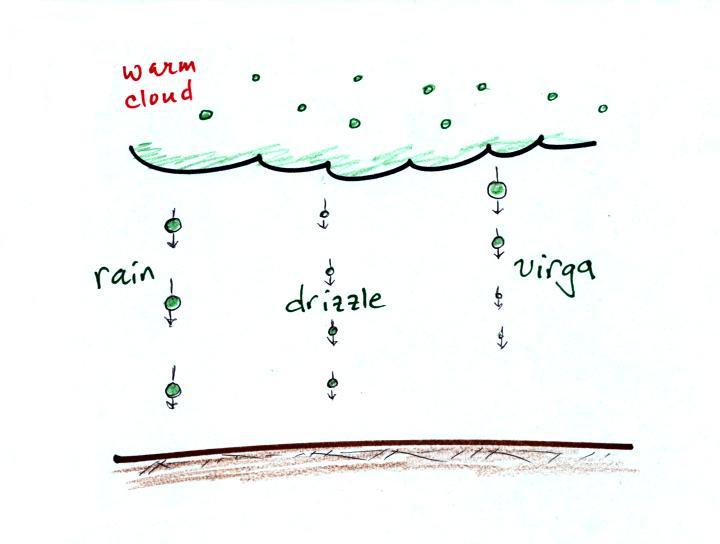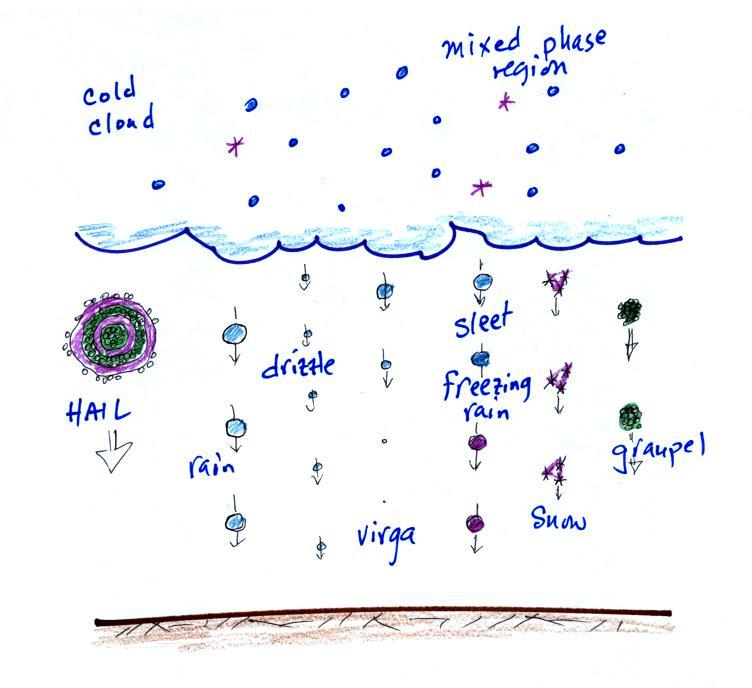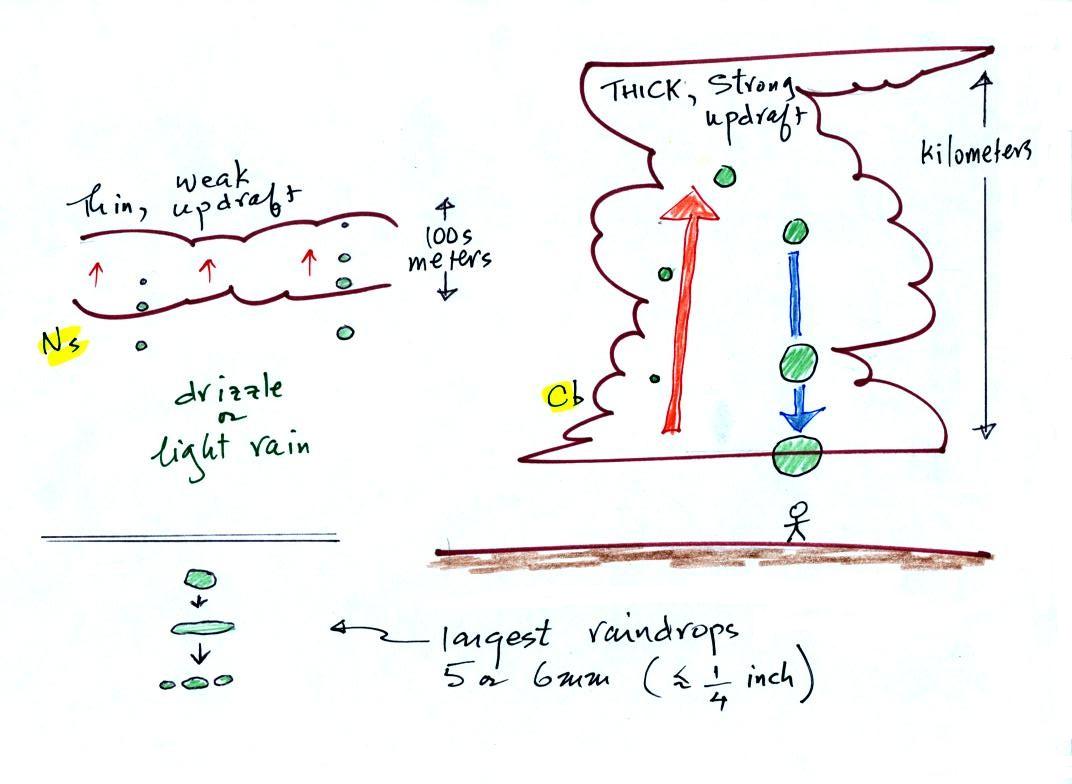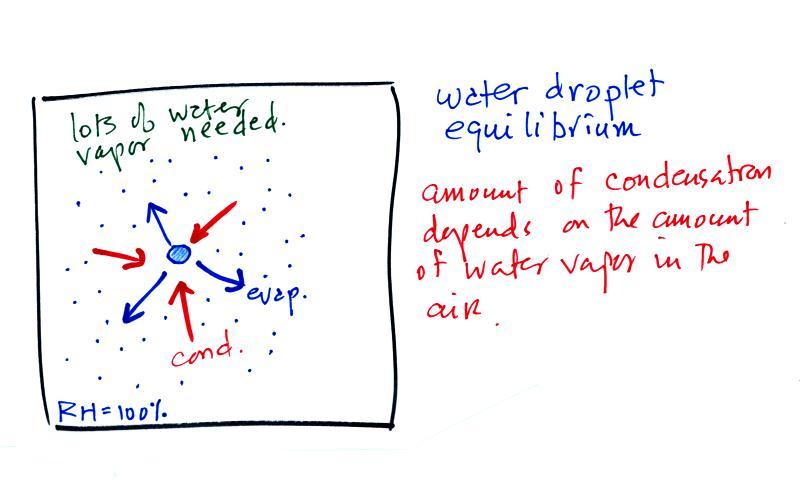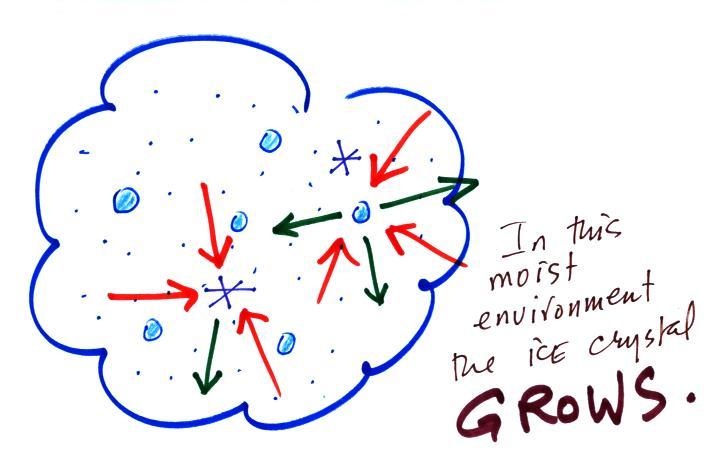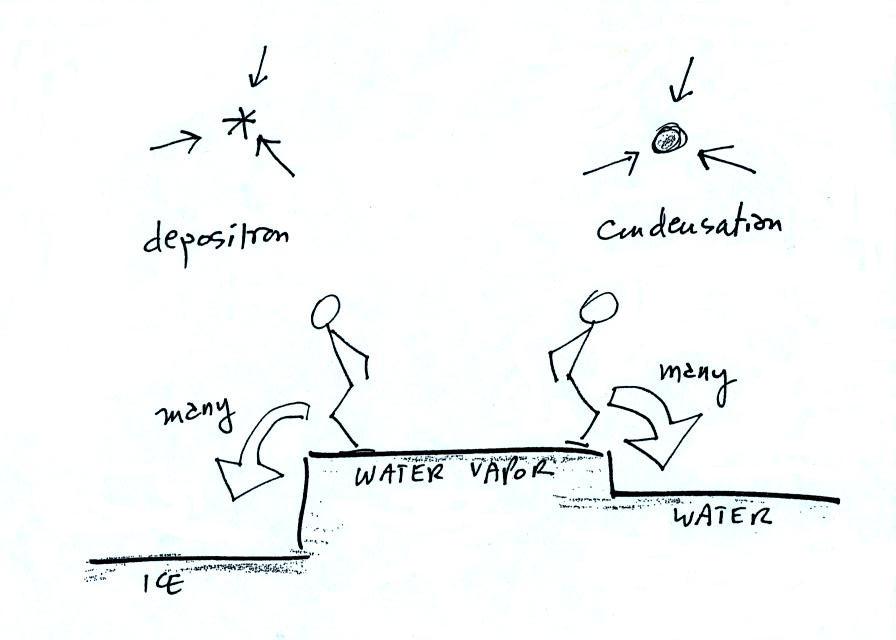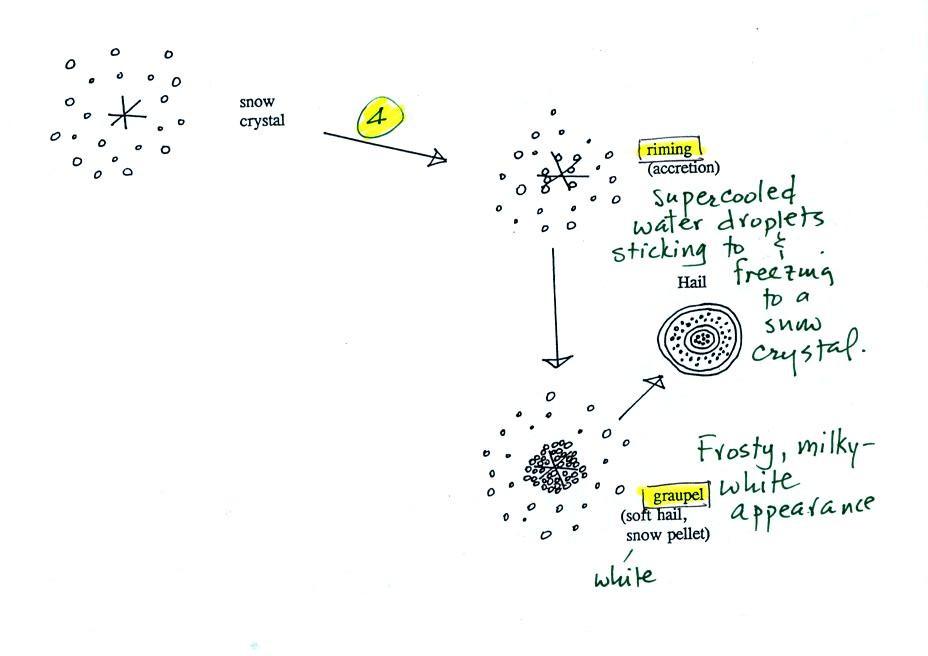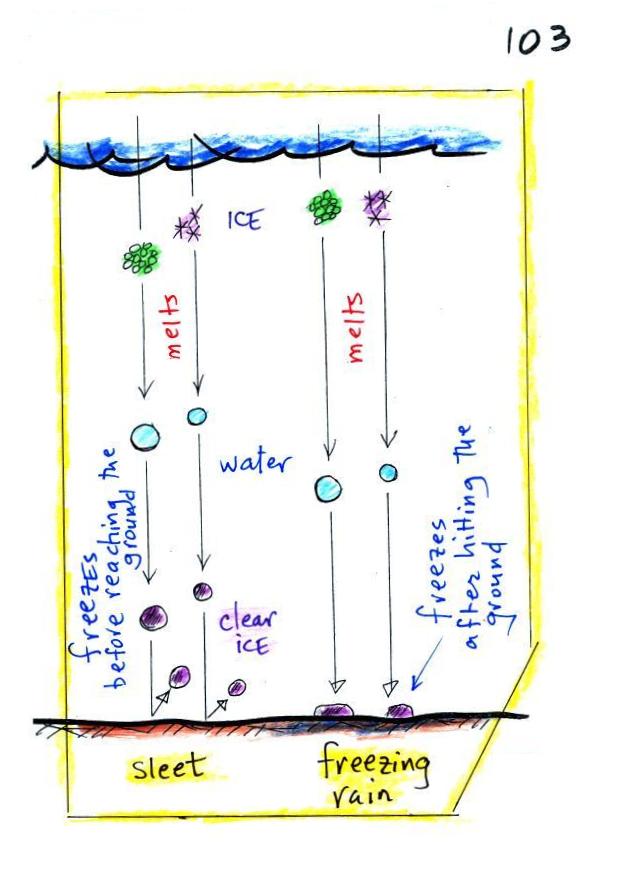Tue., Nov. 5, 2013
Music before class from Tesoro
( a local group). You heard "Motivation" and
"Malaguena". I wasn't able to find either song on
YouTube. A song "Algiers"
from Calexico was stuck in the middle. You can
find music from Tesoro on their "Live in Studio 2A" and "Live at
Hotel Congress" CDs (downloads available from CDBaby.com).
The Humidity Example Problems Optional Assignment was returned
today. Answers
are available online.
The Experiment #3 reports and the 1S1P Assignment #2 reports on
the "Koppen Climate Classification System" were collected
today.
The last big we will cover
before this week's quiz is precipitation formation and types of
precipitation. Only two of the 10 main cloud types
(nimbostratus and cumulonimbus) are able to produce significant
amounts of precipitation. Why is that? Why is it so
hard for clouds to make precipitation?
This figure shows typical sizes of cloud condensation nuclei
(CCN), cloud droplets, and raindrops (a human hair is about 50 μm
thick for comparison). As we saw in the cloud in a bottle
demonstration it is relatively easy to make cloud
droplets. You cool moist air to the dew point and raise
the RH to 100%. Water vapor condenses pretty much
instantaneously onto a cloud condensation nucleus to form a
cloud droplet. It would take much longer (a day or more)
for condensation to turn a cloud droplet into a raindrop.
You must know from personal experience that once a cloud forms
you don't have to wait that long for precipitation to begin to
fall.
Part of the problem is that it
takes quite a few 20 μm diameter cloud
droplets to make one 2000 μm diameter
raindrop. How many exactly? Before answering that
question we will look at a cube (rather than a sphere).
How many sugar cubes would you
need to make a box that is 4 sugar cubes on a side?
It would take 16 sugar cubes to make each layer and there are 4
layers. So you'd need 64 sugar cubes. Volume is
length x width x height.
The raindrop is 100 times wider, 100 times bigger from front to
back, and 100 times taller than the cloud droplet. The
raindrop has a volume that is 100 x 100 x 100 = 1,000,000 (one
million) times larger than the volume of the cloud droplets.
It takes about a million cloud droplets to make one average
size raindrop.
Fortunately
there
are
two
processes
capable
of
quickly
turning
small
cloud
droplets
into
much
larger
precipitation particles in a cloud.
The collision coalescence process works in clouds that
are composed of water droplets only. Clouds like this are
only found in the tropics. We'll see that this is a pretty
easy process to understand.
This process will only produce rain, drizzle, and something
called virga (rain that evaporates before reaching the ground).
The ice crystal process produces precipitation everywhere
else. This is the process that makes rain in Tucson, even on
the hottest day in the summer (summer thunderstorm clouds are tall
and reach into cold parts of the atmosphere, well below
freezing. Hail and graupel often fall from these storms;
proof that the precipitation started out as an ice
particle). There is one part of this process that is a
little harder to understand.
This process can produce a variety of different kinds of
precipitation particles (rain, snow, hail, sleet, graupel, etc).
Here's how the collision coalescence process works. The
picture below shows what you might see if you looked
inside a warm cloud with just water droplets:
The collision coalescence
process works in a cloud filled with cloud droplets of
different sizes. The larger droplets fall faster
than the small droplets. A larger-than-average cloud
droplet will overtake and collide with smaller slower moving
ones.
This is an accelerating growth
process. The falling droplet gets wider, falls faster, and
sweeps out an increasingly larger volume inside the cloud.
The bigger the droplet gets the faster it starts to grow (think
of a growing ball of snow as it rolls down a snow-covered hill
and picks up snow, grows, and starts to roll faster and
faster; or think of an avalanche
that gets bigger and moves faster as it travels downslope)
A larger than average cloud droplet can very quickly grow to
raindrop size.
The figure shows the two precipitation producing clouds:
nimbostratus (Ns) and cumulonimbus (Cb). Ns
clouds are thinner and have weaker updrafts than Cb clouds.
The largest raindrops fall from Cb clouds because the droplets
spend more time in the cloud growing. In a Cb cloud raindrops can
grow while being carried upward by the updraft and also when
falling in the downdraft.
Raindrops grow up to about 1/4 inch in diameter. When
drops get larger than that, wind resistance flattens out the drop
as it falls toward the ground. The drop begins to "flop" or
"wobble" around and breaks apart into several smaller
droplets. Solid precipitation particles such as hail can get
much larger (an inch or two or three in diameter).
The figure below shows the internal structure of cold clouds.
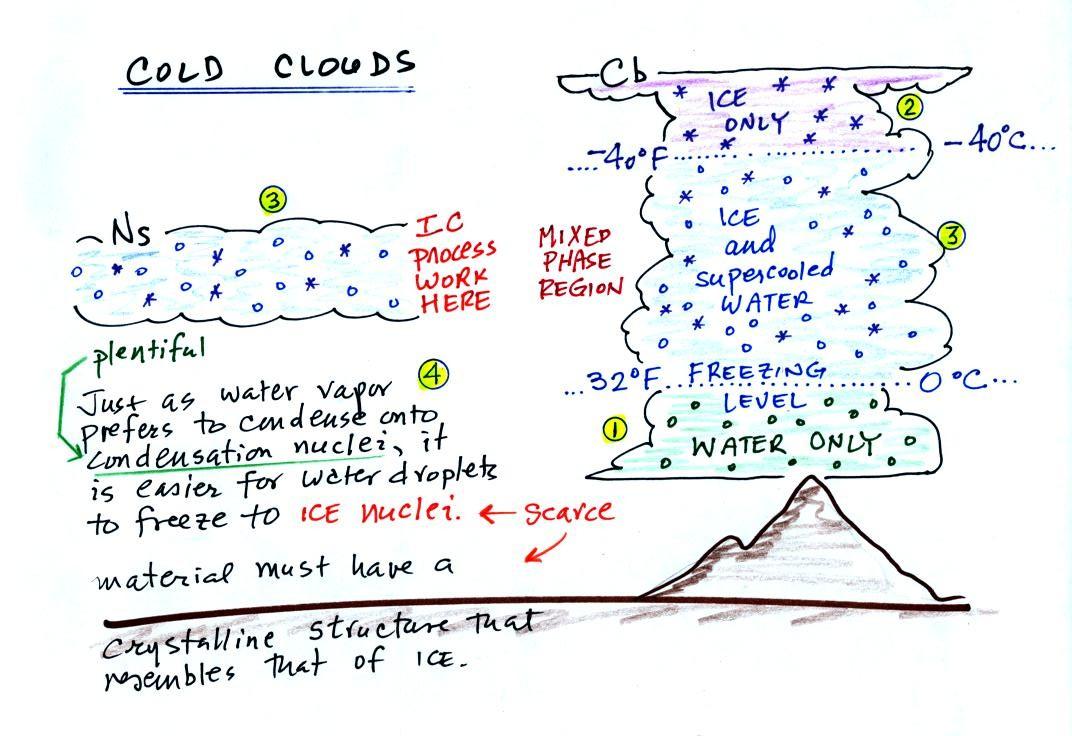
The bottom of the thunderstorm, Point 1, is warm enough (warmer
than freezing) to just contain water droplets. The top of
the thunderstorm, Point 2, is colder than -40 F (which,
coincidentally, is equal to -40 C) and just contains ice
crystals. The interesting part of the thunderstorm and the
nimbostratus cloud is the middle part, Point 3, that contains
both supercooled water droplets (water that has been cooled to
below freezing but hasn't frozen) and ice crystals. This
is called the mixed phase
region. This is where the ice crystal process
will be able to produce precipitation. This is also where
the electrical charge that results in lightning is created.
The supercooled water droplets aren't able to freeze even
though they have been cooled below freezing. At Point 4 we
see this is because it is much easier for small droplets of
water to freeze onto an ice crystal nucleus or for water vapor
to be deposited onto an ice crystal nucleus (just like it is
easier for water vapor to condense onto condensation nuclei
rather than condensing and forming a small droplet of pure
water). Not just any material will work as an ice nucleus
however. The material must have a crystalline structure
that is like that of ice. There just aren't very many
materials with this property and as a result ice crystal nuclei
are rather scarce. In most of the mixed phase region there
are more water droplets than ice crystals.
Here are a couple of demonstrations involving supercooled
water that I showed in class. In the first
demonstration, some supercooled water (cooled to -6 F (-21
C)) is poured into a glass bowl sitting at room
temperature. Just pouring the water into the bowl is
enough of a "disturbance" to cause the supercooled water to
freeze. Just bumping a bottle of supercooled water in the second
video is enough to cause the water to freeze. I
don't know why that happens.
We'll see next why or how the
ice crystal process works, this is the "tricky" part. It's
a 3-step process.
The first figure above (see
p.101 in the photocopied Class Notes) shows a water droplet in
equilibrium with its surroundings. The droplet is
evaporating (the 3 blue arrows in the figure). The rate of
evaporation will depend on the temperature of the water
droplet. There will be some evaporation even from a
droplet that is very cold.
The droplet is surrounded by air that is saturated with water
vapor (the droplet is inside a cloud where the relative humidity
is 100%). This means there is enough water vapor to be
able to supply 3 arrows of condensation. Because the
droplet loses and gains water vapor at equal rates it doesn't
grow or shrink.
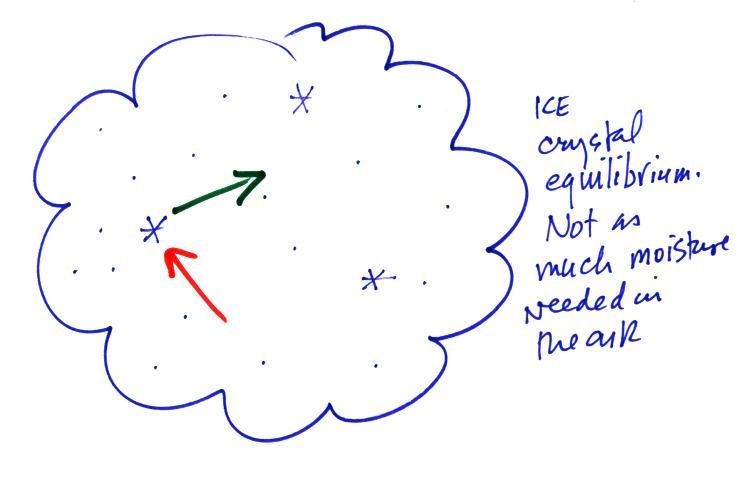
This figure shows what is
required for an ice crystal (at the same temperature) to be in
equilibrium with its surroundings. First, the ice crystal
won't evaporate as rapidly as the water droplet (only 1 arrow is
shown). Going from ice to water vapor is a bigger "jump"
than going from water to water vapor. There won't be as
many ice molecules with enough energy to make that jump. A
sort of analogous situation is shown in the figure below.
The class instructor could and most of the people in the room
could jump from the floor to the top of a 10 or 12 inch tall
box. It would be much tougher to jump to the top of the
table (maybe 30 inches off the ground) or the cabinet (maybe 36
inches) at the front of the room. There wouldn't be as
many people able to do that. Guess what I might be trying
this weekend in my backyard.
To be in equilibrium the ice crystal only needs 1 arrow of
condensation. There doesn't need to be as much water vapor
in the air surrounding the ice crystal to supply this lower rate
of condensation.
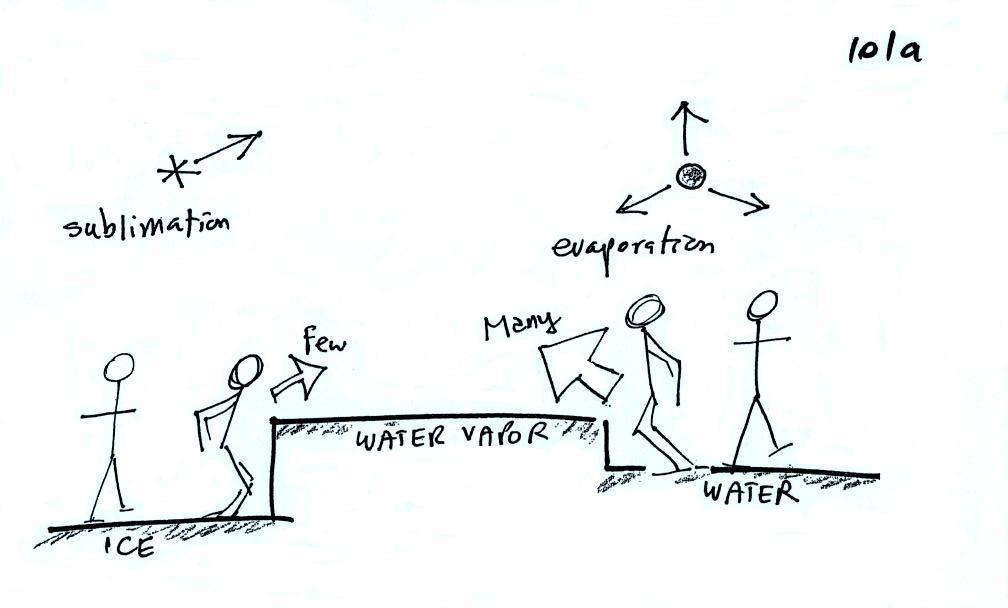
Now what happens in the mixed phase region of a cold
cloud is that ice crystals find themselves in the very moist
surroundings needed for water droplet equilibrium. This is shown
below.
The water droplet is in
equilibrium (3 arrows of evaporation and 3 arrows of
condensation) with the surroundings. The ice crystal is
evaporating more slowly than the water droplet. Because
the ice crystal is in the same surroundings as the water droplet
water vapor will be condensing onto the ice crystal at the same
rate as onto the water droplet. The ice crystal isn't in
equilibrium, condensation (3 arrows) exceeds evaporation (1
arrow) and the ice crystal will grow. That's what
makes the ice crystal process work.
The equal rates of condensation are shown in the figure
below using the earlier analogy.
Most everyone can manage to make the big or the small jump down.
Now
we will see what can happen once the ice crystal has had a
chance to grow a little bit.
Once an ice crystal has grown a little
bit it becomes a snow crystal (this figure is on p. 102 in the
photocopied classnotes). Snow crystals can have a
variety of shapes (plates, dendrites, columns, needles, etc.;
these are called crystal habits) depending on the conditions
(temperature and moisture) in the cloud. Dendrites are
the most common because they form where there is the most
moisture available for growth. With more raw material
available it makes sense there would be more of this
particular snow crystal shape.
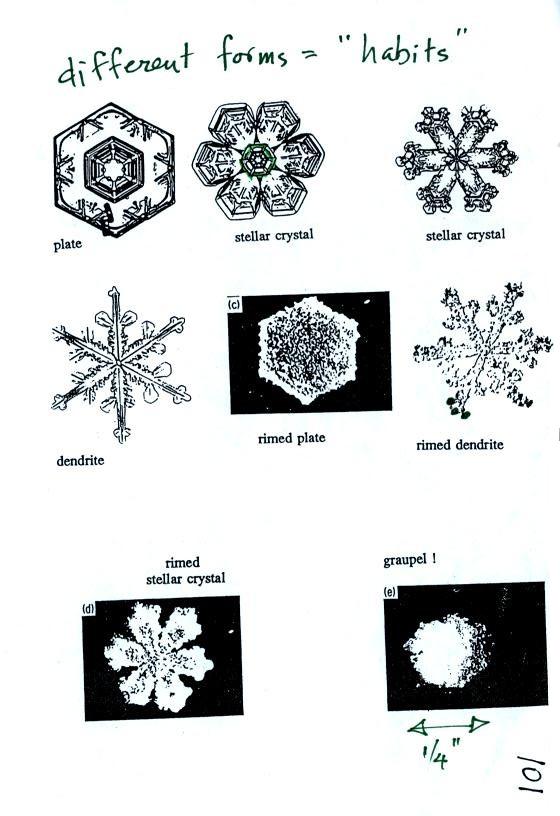
Here
are some actual photographs of snow crystals (taken with a
microscope). Snow crystals are usually 100 or a few 100s
of micrometers in diameter (tenths of a millimeter in
diameter). The different shapes are called "habits".
You'll find some much better photographs and a pile of
addtional information about snow crystals at www.snowcrystals.com.
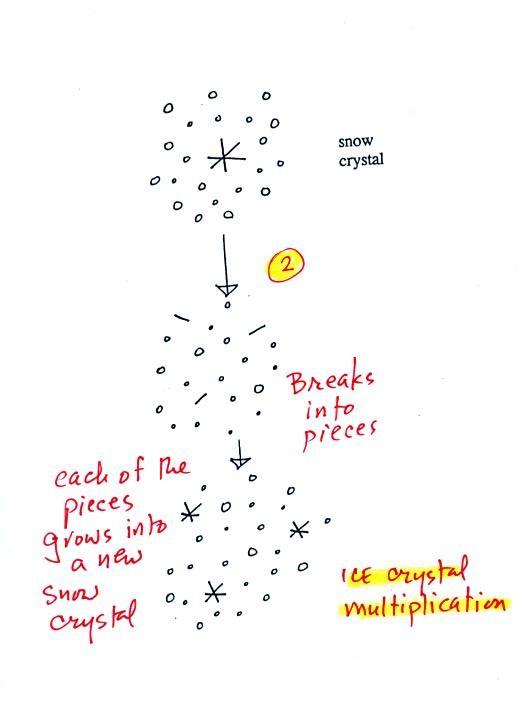
A variety of things can happen once a
snow crystal forms. First it can break into pieces, then
each of the pieces can grow into a new snow crystal.
Because snow crystals are otherwise in rather short supply,
ice crystal multiplication is a way of increasing the amount
of precipitation that ultimately falls from the cloud.
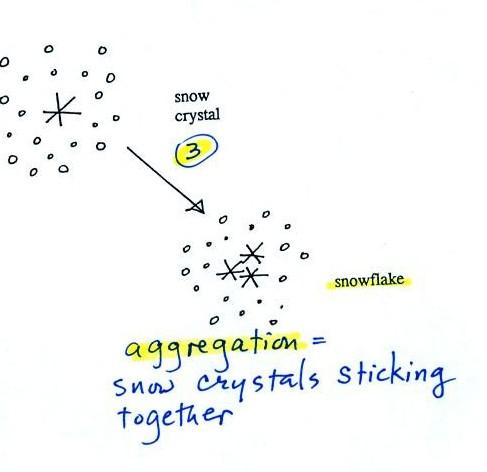
Several snow crystals can collide and
stick together to form a snowflake. Snow crystals are
small, a few tenths of a millimeter across. Snowflakes
can be much larger and are made up of many snow crystals stuck
together. The sticking together or clumping together of
snow crystals is called aggregation (I frequently forget the
name of this process and don't expect you to remember it
either).
The next process and particle are
something that I hope you will remember.
Snow crystals can collide with
supercooled water droplets. The water droplets may stick
and freeze to the snow crystal. This process is called
riming or accretion (note this isn't called collision
coalescence even though it is the same idea). If a snow
crystal collides with enough water droplets it can be
completely covered with ice. The resulting particle is
called graupel. Graupel is sometimes mistaken for hail
and is called soft hail or snow pellets. Rime ice has a
frosty milky white appearance. A graupel particle
resembles a miniature snow ball. Or smaller finer
grained version of the shaved ice in a "snow cone."
Graupel particles often serve as the nucleus for a
hailstone.
This figure gives you an idea of
how hail forms.

In
the figure above a hailstone starts with a graupel particle
(Pt. 1, colored green to represent rime ice). The
graupel falls or gets carried into a part of the cloud where
it collides with a large number of supercooled water droplets
which stick to the graupel but don't immediately freeze.
The graupel gets coated with a layer of water (blue) at Pt.
2. The particle then moves into a colder part of the
cloud and the water layer freeze producing a layer of clear
ice (the clear ice, colored violet, has a distinctly different
appearance from the milky white rime ice), Pt. 3. In Tucson this is often the only example of hail
that you will see: a graupel particle core with a single layer
of clear ice.
Hail that falls to the ground in Tucson usually just has a
graupel core and a single layer of clear ice. In the
severe thunderstorms in the Central Plains, the hailstone can
pick up additional layers of rime ice and clear ice and
hailstones can be composed of many alternating layers of rime and clear
ice. An unusually large hailstone (around 3 inches
in diameter) has been cut in half to show (below) the
different layers of ice. The picture below is close to
actual size. If something like this were to hit you in
the head it would split your skull open. Here's some
pretty good video of a hailstorm
in Phoenix.
Hail is produced in strong thunderstorms
with tilted updrafts. You would never see hail (or
graupel) falling from a nimbostratus cloud. A new record
was apparently set for a
large hailstone in Hawaii in March of this year.
Hawaii is an unusual place for hail this large to be found.
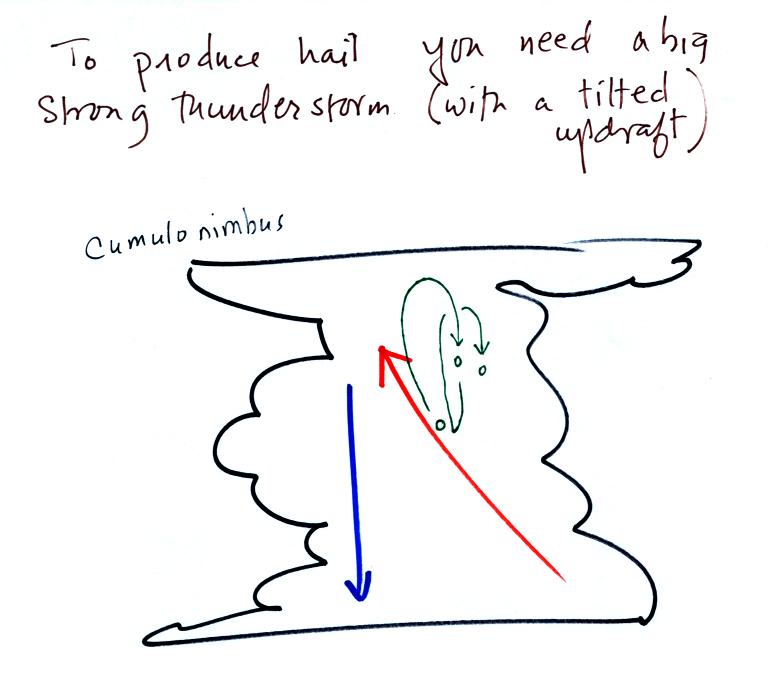
The growing hailstone can fall
back into the updraft (rather than falling out of the cloud)
and be carried back up toward the top of the cloud. In
this way the hailstone can complete several cycles through the
interior of the cloud. The article above mentions a
supercell thunderstorm. We will discuss these later in
the semester.
Finally on p. 103 in the
ClassNotes are illustrations of some of the things that can
happen once a precipitation particle falls from a cloud.
I've split this into two groups for clarity.

Essentially all the rain that
falls in Tucson is produced by the ice crystal process.
The left figure above shows how this happens. A falling
graupel particle or a snow flake moves into warmer air and
melts. The resulting drops of water fall the rest of the
way to the ground and would be called RAIN.
In the middle picture graupel particles can survive the trip
to the ground without melting even in the summer. Many
people on the ground would call this hail but that wouldn't be
quite right. Graupel is less common in the winter because
it comes from thunderstorms and they don't form very often in
the winter. Snow can survive the trip to the ground in the
winter but not the summer.
Sometimes the falling raindrops will evaporate before reaching
the ground. This is called VIRGA and is pretty common
early in the summer thunderstorm season in Arizona when the air
is still pretty dry. Lightning that comes from
thunderstorms that aren't producing much precipitation is called
"dry lightning" and often starts brush fires.
Rain will sometimes freeze before reaching the ground.
The resulting particle of clear ice is called SLEET.
FREEZING RAIN by contrast only freezes once it reaches the
ground. Everything
on the ground (the image shows a car) can get coated with
a thick layer of ice. It is nearly impossible to drive during one of these
"ice storms." Sometimes the coating of ice is heavy
enough that branches
on trees are broken and power
lines are brought down. It sometimes takes several
days for power to be restored.
